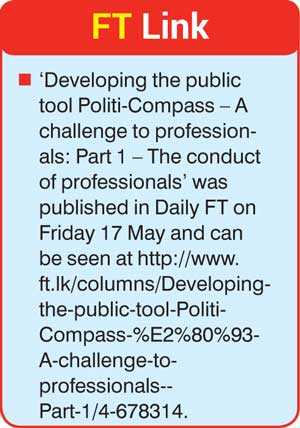Tuesday Apr 15, 2025
Tuesday Apr 15, 2025
Tuesday, 21 May 2019 00:00 - - {{hitsCtrl.values.hits}}
Democracy
Democracy is a double-edged sword. If one wields it too aggressively, it will inflict self-injuries. Democratic freedom is not akin to the freedom enjoyed by a wild donkey. One can exercise own human rights to the extent that the behaviour would not harm wellbeing of the majority of society. Hence, an elected government is expected to put control mechanisms to individual human behaviours for wider public benefit.
The issue here is how well a government understands this limit and acts. In Australia, democratic freedom is managed very well. When the Government take an action against a person or group of people on the basis of undesirable behaviour, the Government knows that it sometimes could constitute the violation of individual human rights. However, the aim is to justify the action at the right time and right way for societal benefit.
The Australian Government knows that the subjected individual or the group would go to the Court, citing human right violation. If the court decides such a violation occurred during the process, the Government would pay a compensation fee happily as the original goal was to achieve community benefit and it had been achieved.
In Sri Lanka, the Government acts in a similar manner but without comparing the type of actions against the achievable societal benefit. This is why some of the previous incidents involving elected governments come back and haunt the people who took such decisions as gross violation of human rights. Simply, those decision makers are not in a position to justify the public benefits of their actions.
Australian election process
When I travel back and forth daily from my office, I don’t feel that the federal election is going to be held this month. I cannot see a single cut-out of figure of the prime minister or the opposition leader or any other politician in a public place. Intermittently, I see someone displaying a small placard of a politician in a window or a short picket in the front yard of a private house. However, I see many paid television advertisements, newspaper ads and social media promotions and also promotional material in my mailbox.
The idea here is that Australian people have the democratic choice of ignoring those promotions by switching off the television and the social media stream and not buying the newspaper and also putting any promotional material into the Council-collected recycle bin. When they go out to a public place, they have a right not to be disturbed by political propaganda material. By now, five election candidates have been forced to resign. This is because they violated democratic values of the society and the party leaders decided not to field them.
It is better not to write about the political propaganda process and candidature selection process in Sri Lanka as it is a waste of space of this publication.
Australian professionals and journalists
How do the professionals and the media work together in Australia?
The main aim of any politician is to get-elected to a political office. In this regard, both Australian and Sri Lankan politicians are on the same page. All make promises to the voters. When the Australian Federal politicians make promises, the promise should strictly be pre-endorsed by his/her political party hierarchy as the promise should comply with the written policies of the party.
If any nominee makes a statement violating the policies of the party, the partly leader immediately corrects it. All major public promises strictly come from the leader of the party because the elected Prime Minister will be responsible for the delivery of all the promises.
The interesting part is the character of the promises and the professional response.
A promise should come up with four main features; tangible and intangible details of the delivery, who are the beneficiaries, how much it would cost to deliver and where money is found for delivering the promise.
Immediately after a politician makes the promise, professionals start analysing the promise. They independently cost it, check its deliverability under current legislative framework and whether this promise is in line with the policies of the particular political party. The analysts do not stop there. They compare this policy with other similar policies of other rival political parties and present it to the public via media. So, the public knows exactly what is on offer.
Then, based on analysed details, journalists question the politicians vehemently on anomalies of the promises.
Finally, analysts put all the promises into a single basket and calculate the total cost and question the politicians what existing services would be cut to fund all the promises the party made. The future and trustworthiness of politicians depend on their response to the analysts.
Recently I witnessed that the media professionals went another step ahead. 
The Australian Broadcasting Corporation (ABC) is the Australia’s national broadcaster and it is principally funded by Australian Government. However, it is independent of Government and partisan politics. ABC joined hands with professionals in the University of Melbourne and developed a tool called Vote-Compass for exploring how public views are aligned with those of the political parties.
The Vote-Compass questionnaire (propositions) starts with an optional input of the electorate, the voter resides. Thereafter, the questions and statements on topics important for general public are presented one by one. For the questions, the voter must select one answer out of the five relatively quantitative answers; ‘much less’, ‘somewhat less’, ‘about the same as now’, ‘somewhat more’ and ‘much more’. Further, the voters have the option to say “don’t know”, if applicable.
The statements come with the answers; ’strongly disagree’,’ somewhat disagree’, ‘neutral’, ‘somewhat agree’, ‘strongly agree’ and ‘don’t know’. There are 30 propositions for the voters to respond. Then, this tool extends the information collection on political parties and party leaders. It asks whether you support a particular party’s stand irrespective of you vote this time for another party. Also, it prompts the voter to rate trustworthiness of each party leader as well as the voter’s opinion on to which party, the people in the electorate would cast their votes. Next, the voter is asked to express opinion on the competency of each party leader.
There are a number of additional questions on the voter’s personal understandings on policies and on the personal behaviours, annual income, social status, religion etc. This is to gauge the personality of the voter. Finally, the output of the analysis is displayed.
One output is the voter’s position in political landscape, surrounded by socially conservative and progressive political parties and the economic right and left parties. The second output is how much the voter agrees with the policies of each party. It prompts the voter to vote the top listed party if he or she wants the political expectations are met. Also, it displays the voter’s personality ratings on the leaders.
The Vote-Compass further helps the user to compare different policy stands of political parties. So, this works as an education tool as well. If the voter prefers, the results could be emailed as a report.
I used this tool and I was really fascinated by the effort of the political scientists, IT professionals and the media organisations to help voters to understand policies of political parties and to which party they should vote to meet their expected outcomes. This is a very important public awareness process for a country like Australia where voting is compulsory for the public in State and National elections. Australian politicians are ethical to support such a process.
Lessons for Sri Lanka
Could a similar process be adopted in Sri Lanka?
The answer is “yes”, but the tool should be modified because the political parties in Sri Lanka do not have “written policies” and the public do not vote on “policies” even if the policies exist. Hence, for Sri Lanka, initial step would be an educational process followed by an opinion testing process.
The initial step would require asking the political parties to respond with their transparent strategic policies relevant to the complete spectrum of the public service sectors and the governance areas. Thereafter, the tool can be pre-populated with party policies and it would act as an educational resource for the tool users.
It is important not to reveal the political party identities for each listed policy but only naming the parties as Party 1, 2, 3, etc. As Sri Lankan political parties are traditionally not good at developing holistic national policies, the political scientists should develop best practice policies for each area and display those policies under a quasi-political party number.
Then, the second part of the questionnaire could be used to test the knowledge of the voters on policies. After the users having clear understanding about the policies, the third section of the tool could be used to express own policy opinions and the rating of political leaders in terms of competency and trustworthiness.
At the completion of this exercise, the user of the tool (a voter) would know for which political party, he or she should cast the vote. As the best practice policies are also there, there is a possibility that a voter will end up selecting the quasi-political party. If that happens with the majority of users, then, there is definitely a major problem with the current Sri Lankan political culture as none of the available political parties is qualified to govern the country. The media must highlight such outcomes and force existing political parties to adopt best practice policies, otherwise expect the possibility of wholesale rejection from people.
So, I would like to challenge Sri Lankan professionals, political scientists, IT professionals and media personnel to get together and implement a local tool akin to the Vote-Compass tool implemented by the Australian Broadcasting Corporation. I name it ‘Politi-Compass’.
(Eng. Janaka Seneviratne is a Chartered Professional Engineer, a Fellow and an International Professional Engineer of both the Institution of Engineers, Sri Lanka and Australia. He is contactable via [email protected].)
